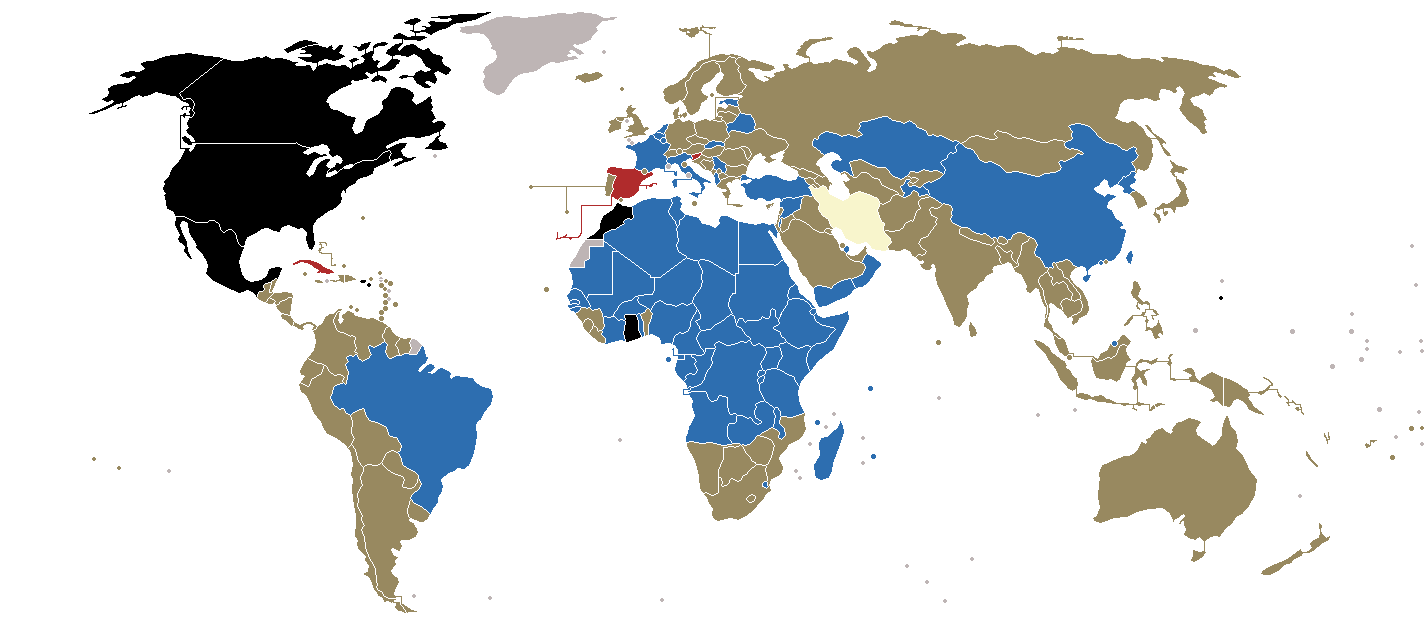A Look Ahead to World Cup 2026 in USA-Canada-Mexico
By Ryan Metivier in Soccer News
Published:

- The United bid from USA-Canada-Mexico won out over Morocco to host the 2026 World Cup
- How will an expanded field of 48 teams effect the tournament?
- Which homegrown stars could shine in 2026?
It’s been 24 years since the World Cup was last hosted in North America. Back in 1994 the USA hosted the tournament making it to the Round of 16. Brazil would go on to win that World Cup over Italy in penalties.
The bids to host the 2026 World Cup came down to The United bid between USA-Canada-Mexico, as well as a bid from Morocco. On June 13 FIFA member associations voted 134-65 (with one No Vote) in favor of the North American bid.
On June 13 FIFA member associations voted 134-65 in favor of the North American bid.
This will be the second time USA will host. Mexico hosted the tournament in both 1986 and 1970 and Canada has never hosted. While USA and Mexico are typically regulars in the tournament, Canada has qualified just once back in 1986.
That could change in 2026 as host nations are historically granted automatic entry into the tournament. For instance, Russia bypassed the entire qualification process as this year’s hosts. There is also precedent for multiple nations gaining automatic entry. The last co-hosting nations were South Korea and Japan in 2002 and both gained entry as hosts.

For now though, the decision to grant automatic qualification into the tournament for all three countries has yet to be decided by the FIFA Council. With the World Cup expanding from its current 32-team format and up to 48 for 2026—the entire qualification process has yet to be confirmed.
Who Can We Expect to See in an Expanded Field?
More teams means more money and that is something FIFA just couldn’t turn down when considering expanding the field. The United bid quoted expected profits of $11 billion (USD) for FIFA. In fact there is even talk FIFA is pushing to expand the field in 2022 in Qatar.
The United bid quoted expected profits of $11 billion (USD) for FIFA.
Your perennial powerhouse nations will always be there. But this will leave the door open a little bit wider for your USA’s, Italy’s and Holland’s. These countries were all unlikely absentees from this year’s tournament who came up just short in qualifying. Some will argue an expanded field will produce a watered down product. We already have the 67th ranked Saudis and 70th ranked Russians in the tournament. However the Russians, as well as many other “lesser nations” have acquitted themselves well thus far in this year’s World Cup.
In May 2017 the FIFA Council approved a new slot allocation for how many teams from each confederation will qualify for 2026. They are as follows:
World Cup Slot Allocation by Confederation
| Confederation | Slots |
|---|---|
| AFC | 8 |
| CAF | 9 |
| CONCACAF | 6 |
| CONMEBOL | 6 |
| OFC | 1 |
| UEFA | 16 |
| Playoff (1 team from each confederation will compete) | 2 |
With the additional spots per confederation and considering the teams that just missed out this year, let’s take a hypothetical look at who could’ve qualified in 2018 had the field already been expanded.
Instead of three and half spots, CONCACAF will have six. With that, potentially the final round of six teams—Round 5 or the “Hex”, could be eliminated. The three countries that missed out from this round were Honduras, USA and Trinidad and Tobago.
In the AFC, eight spots are up from four and half. In Round 3 of qualifiers the top two teams from two pools of 12 advanced. If that was expanded to the top four from each, we could’ve seen Syria, Uzbekistan and the United Arab Emirates. Australia was also in this group but did qualify through a playoff or as the current format’s .5 allocation spot. For Syria and Uzbekistan they would be debuting in their first tournaments.
Similarly moving from five to nine spots in CAF would see four more African nations. In Round 3 of current CAF qualifying, the top team from five groups advanced. The second place teams from these groups this time around were Congo, Zambia, Côte d’Ivoire, Burkina Faso and Uganda. Zambia, Burkina Faso and Uganda have yet to make World Cup appearances.

With CONMEBOL’s additional spots increasing to six from four and half, we could’ve seen 2016’s Copa America champs Chile in the World Cup. Peru would’ve gained automatic qualification instead of needing an additional intercontinental playoff as well.
OFC currently has no automatic berths. As the top team in the region, New Zealand played in an intercontinental playoff against Peru and lost. With one guaranteed spot we could’ve seen the Kiwis for only the third time ever.
With three more spots in UEFA, any of Northern Ireland, Republic of Ireland, Greece or Italy could’ve qualified instead of being eliminated in the final round of playoffs.
Future World Cup Stars
From a USA and Canada perspective, eight years from now some of their brightest stars will be in their prime in American Christian Pulisic and Canadian Alphonso Davies.
The “Wonderkid” Pulisic is only 19 but is plying his trade at one of the biggest league’s in the world right now. An attacking midfielder or winger, he scored four goals this year with Borussia Dortmund of the German Bundesliga. His name is repeatedly in transfer talks surrounding moves to other top clubs in Europe.

Davies, only 17, plays for Major League Soccer’s (MLS) Vancouver Whitecaps. Though he’s not eligible to win the Whitecaps’ “Budweiser Man of the Match” award being under the legal drinking age—all he’s done is continue to break records.
At 15 he became the youngest player to sign a contract and to score in the United Soccer League. He was called up to the Whitecaps at 15 as well, and in 2016 was the third youngest to sign an MLS contract and second youngest to play and start a match. Internationally he holds the distinction of being the youngest player to play and score for Canada’s Men’s National Team.

Growing the Game
Soccer around the globe is one of if not the biggest sport in many countries. However, it still ranks far, far down the list of popularity in Canada and the United States.
But hosting a World Cup creates new fans. The 1994 World Cup in USA still ranks as the highest attended tournament. Total attendance was 3,568,567 with an average attendance per game of 68,626.
The 1994 World Cup in USA still ranks as the highest attended tournament at 3,568,567 with an average attendance per game of 68,626.
Also consider that MLS did not even exist in 1994. The creation of a top tier league was a condition of USA hosting the tournament. The MLS may still not rank among the world’s elite in regards to level of talent. However, it has expanded to 23 teams and more are on the way. It has attracted such stars as David Beckham who signed with the LA Galaxy in 2007. Since then, others like Andrea Pirlo, David Villa, Steven Gerrard, Sebastian Giovinco and most recently one of the biggest names in world soccer Zlatan Ibrahimović have followed suit.

Bookmakers saw record handle when the United States advanced to the Knockout Stage in 2014. With the advent of legal sports wagering in the US, the potential for increased interest eight years from now is monumental.
For a nation like Canada and others who rarely stand much of a chance at qualifying for the tournament, consider this when thinking about the impact of an expanded field. This year, Iceland entered their first World Cup in the country’s history. The Icelandic Football Association released stats that 99.6-percent of TVs in Iceland were tuned into the team’s first game of the Group Stage against Argentina. By comparison the Super Bowl usually attracts about 45-percent of American viewers.
99.6% of people watching TV in #Iceland on Saturday afternoon were watching the team’s first #WorldCup match against Argentina? https://t.co/FeTnitpVXm pic.twitter.com/uwtsB4n2sN
— Iceland Naturally (@IcelandNatural) June 21, 2018
Where Will Games be Played?
That depends. World Cup games will be played in 16 different cities across the three hosting countries. Currently there is a list of 23 cities which have put forth bids to host. A record 80 matches will be played, of which 60 will be played in USA. The additional 20 games will be split evenly at ten each between Canada and Mexico. Also, from the quarter-finals on, all games will be played in the USA.
Below you will find a list of which cities have made bids to host.
World Cup 2026 Potential Host Cities
| Country | City |
|---|---|
| Canada | Edmonton |
| Canada | Toronto |
| Canada | Montreal |
| USA | Seattle |
| USA | San Francisco/Bay Area |
| USA | Los Angeles |
| USA | Denver |
| USA | Kansas City |
| USA | Dallas |
| USA | Houston |
| USA | Nashville |
| USA | Atlanta |
| USA | Orlando |
| USA | Miami |
| USA | New York/New Jersey |
| USA | Philadelphia |
| USA | Baltimore |
| USA | Washington |
| USA | Cincinnati |
| USA | Boston |
| Mexico | Monterrey |
| Mexico | Guadalajara |
| Mexico | Mexico City |

Sports Editor
Ryan is SBD's resident soccer pro, though his repertoire is by no means limited to a single sport. His articles have been published by the Canadian Hockey League (CHL), Ontario Hockey League (OHL), and the Kitchener Rangers, and outlets like SportsXpress and Shredthespread.com



